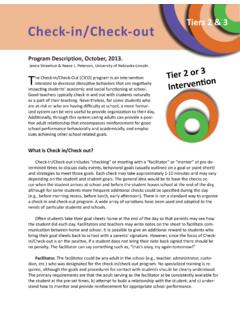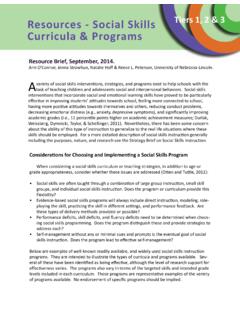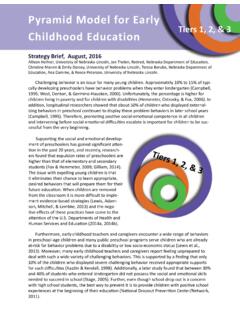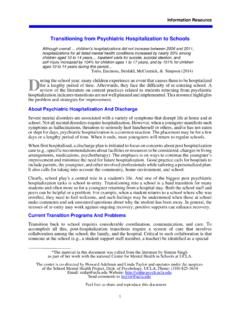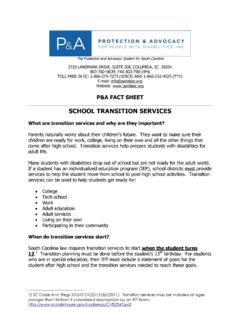Transcription of Examples of Middle to High Tiers 1, 2 & 3 School ...
1 Examples of Middle to high School transition ProgramsTiers 1, 2 & 3 Below are listed a variety of transition programs that schools have used to address Middle to high School transition . Some of these programs also have other elements designed to prevent students from dropping out. Several of the programs are widely used across the country while others are specific to a School or district. These Examples may provide ideas which would be useful to emulate for schools creating these transition programs, either at the Middle or high School levels. Talent Development high School model /Ninth-grade Academies .. A comprehensive School reform model developed by the Center for Research on Students Placed at Risk, based at Johns Hopkins University, and Howard University (Neild, 2008, p.)
2 18). Ninth Grade Academy is located in a physically separate section of the School building (Neild, 2008, p. 18). Teachers .. are divided into teams made up of math, English, social studies, and science faculty who teach the same groups of students. These teams of teachers, led by a Team Leader, meet frequently throughout the year to discuss the academic progress of their ninth graders (Neild, 2008, p. 18). Key features: 1) personalized School , 2) curricula specifically designed to help students back-fill on skills they are lacking, 3) professional development for teachers (Neild, 2009, p. 13). Study found that Talent Development ninth graders attendance, total credits earned, credits earned in algebra, and on-time promotion to tenth grade exceeded those of ninth graders at the comparison schools (Neild, 2009, ).
3 Reference: to high School transition applies typically to eighth graders who would be transitioning to a high School , as well as ninth grade students who have recently been enrolled in a high School . While evidence suggests that providing a variety of supports to all students making that transition is valuable, it may be especially important to provide even more intense supports to those students who are at higher risk levels of dropping out. A variety of risk calculators addressed elsewhere may be used to assess the risk level of specific Description, May, 2013. Jeaneen Erickson, Reece L. Peterson, & Paige Lembeck, University of be adapted toTier 1, 2 or 3 InterventionExamples Middle to HS transition 2 Freshman transition Classes Premise: individuals don t work hard until they understand the benefits of their efforts.
4 Course Standards for Freshman transition Classes: blueprint for well-designed freshman courses that not only carry the same rigor, credibility and status of traditional academic courses, but that also increase School retention, academic achievement, and postsecondary matricula-tion. A successful standards-based Freshman transition Course has five requirements: 1) A 10-year education and career plan for every student. 2) A curriculum that meets the Course Standards for Freshman transition Classes. 3) Well-qualified teachers. 4) Leadership continuity over the first four years. 5) A systemic and sustainable School -wide implementation initiative.
5 Can be applied as a stand-alone eighth- or ninth-grade freshman transition class, used as the foundation for freshman academies or career pathway programs, or integrated into academic courses such as English, social studies and mathematics. Standards provide content and themes that enable students to understand why high School matters (Dedmond, 2008). A 10-Step Plan in Appendix (Dedmond, 2005). Reference: Provides incoming ninth-grade students with enriching summer activities that give academic support, advancement, and motivation to excel in high School through career-related field trips and other relevant activities (Cohen & Smerdon, 2009, ).
6 Reference: ; Centers .. Organizational structure to combat poor performance in ninth grade (Smith et al., 2008, p. 2).. Create a sense of community often absent in a large high School and to ease the academic and social transition from Middle School to high School (Smith et al., 2008, p. 2).. Operate more like Middle schools than traditional high schools, including the use of team-ing, where the larger student body is arranged in houses or teams that share a set of teachers (Smith, 2008, p. 2). There is relatively little research on the impact of freshmen centers on students outcomes and no research on the role of freshmen centers on educational transition (Smith, 2008, p.)
7 2).Reference: - (Journal Article: Smith, J. S., Akos, P., Lim, S., & Wiley, S. (2008). Student and stakeholder perceptions of the transition to high School . high School Journal, 91(3), 32-42.)SUCCESS (Students Under Cluster Care Experience School Success)Frederick County (Maryland) Public Schools, Brunswick Middle School and Brunswick high School Middle School and high School collaboration program Teams of two or three teachers from each School building meet every other month to dis-cuss and share instructional issues, and assessment data on students (Oakes & Waite, 2009, p. 3). SUCCESS teams receive reports from each School administrator after monthly meetings at which all School administrators discuss common issues and develop common practices that are instituted in all their schools (Oakes & Waite, 2009, p.
8 3). Reference: No website- see Oakes & Waite ProgramFrederick County (Maryland) Public Schools, Brunswick Middle School and Brunswick high School Posters that depict The Ideal Brunswick Graduate are posted throughout Brunswick schools and community buildings, outlining key characteristics of what each Brunswick student will know and be able to do when he or she graduates (Oakes & Waite, 2009, ). Brunswick guidance counselors meet with eighth graders to share information about high School courses and the academic and social expectations in high School (Oakes & Waite, 2009, ).. Write a personal four-year plan for their high - School career with supporting information from their teachers, parents, and guidance counselors (Oakes & Waite, 2009, ).
9 These plans are sent home to parents, kept in students School files, and used to help stu-dents select their classes during ninth-grade registration (Oakes & Waite, 2009, ).. Monitored over the course of their high - School careers, to match eighth-grade planning with the four years of high - School reality (Oakes & Waite, 2009, ). Reference: No website- See Oakes & Waite Middle to HS transition 3 Charting the Course Assemblies, Hammond Middle School (Laurel, Maryland) .. Assemblies for their eighth graders, showing a movie Charting the Course that directly addresses issues that transitioning teens might encounter (Oakes & Waite, 2009, ).
10 Strive to engage students in dialogue about the issues presented in the movie (Oakes & Waite, 2009, ).. Former Hammond students, now ninth and tenth graders, have a roundtable discussion onstage with a representative group of current Hammond eighth graders, in front of the eighth graders peers (Oakes & Waite, 2009, ). The roundtable is meant to ground the issues of the movie in the reality of Hammond s eighth graders (Oakes & Waite, 2009, ). Student attendance and achievement are on the rise, and both parents and students voice their appreciation for the activities that provide them with information and support to make the change a successful one (Oakes & Waite, 2009, ).
